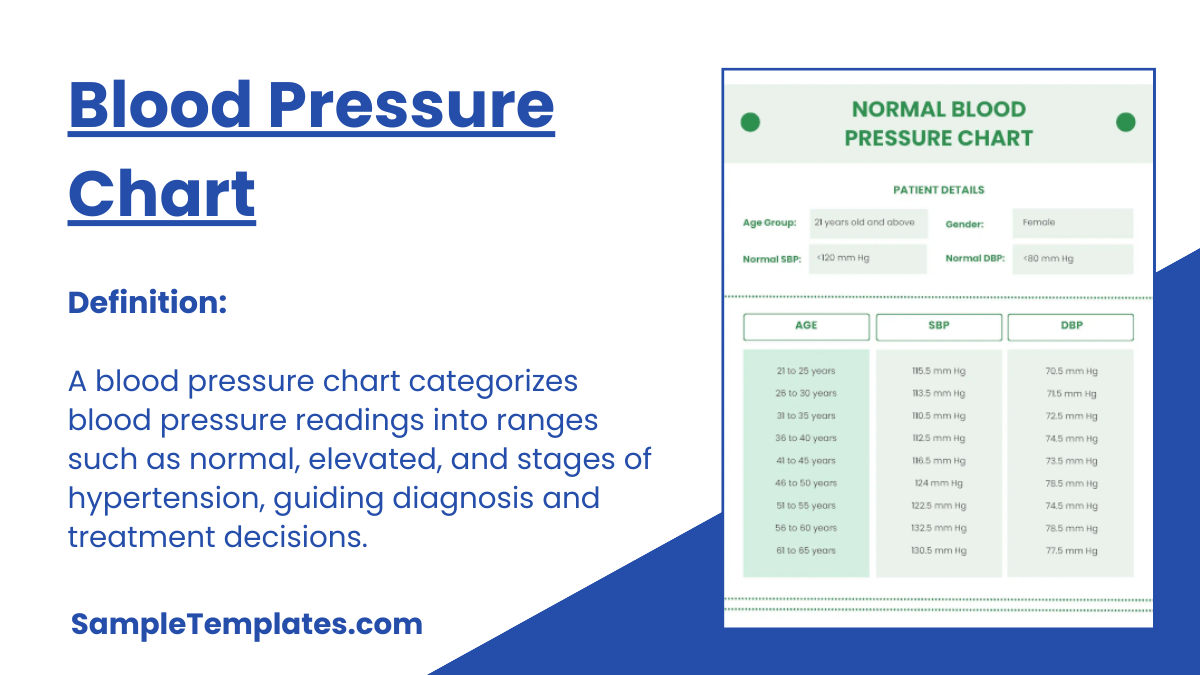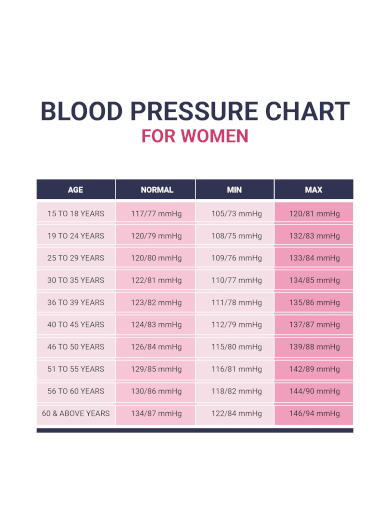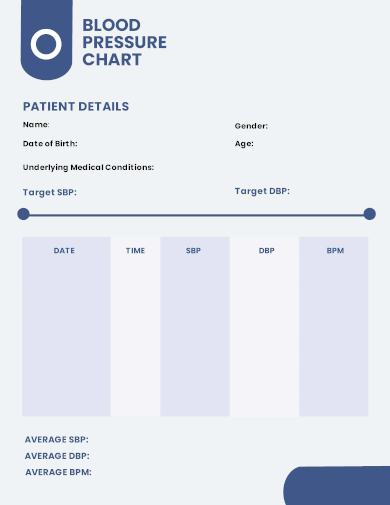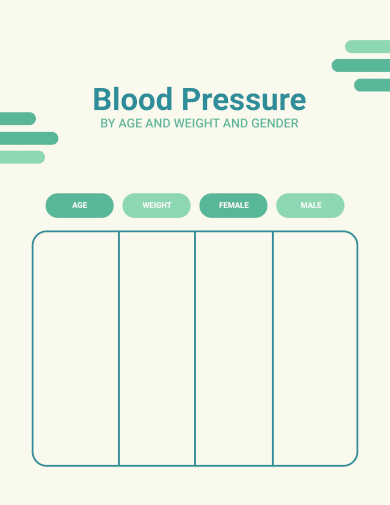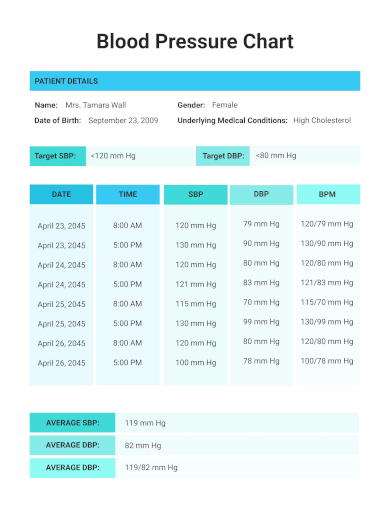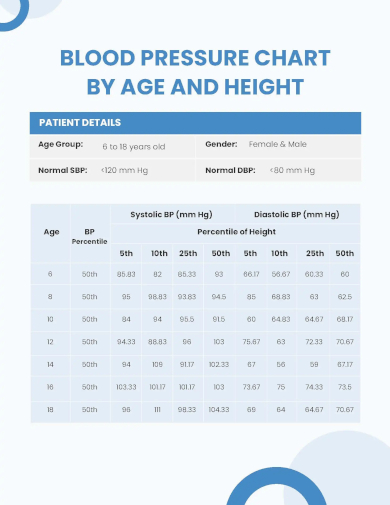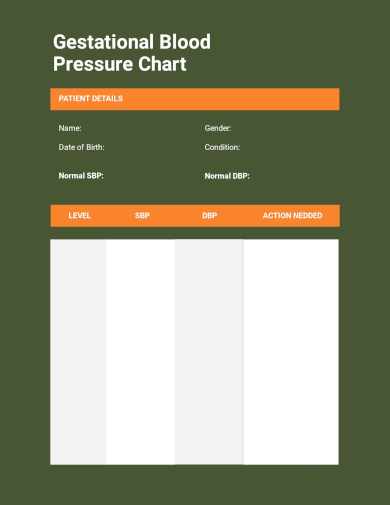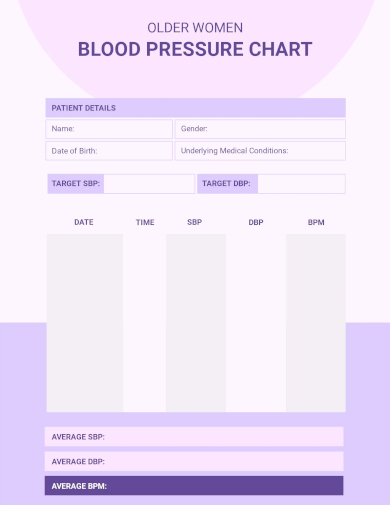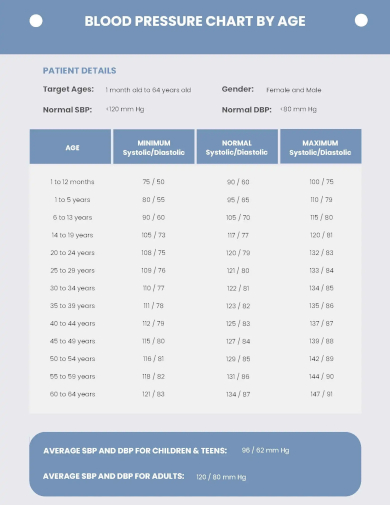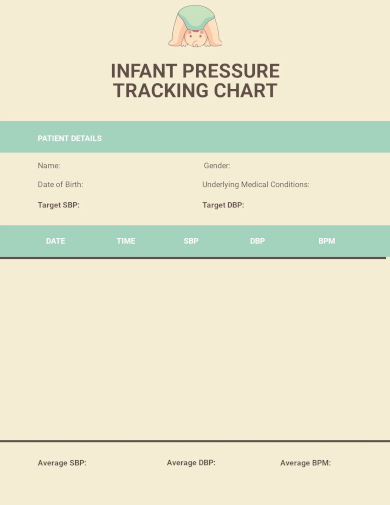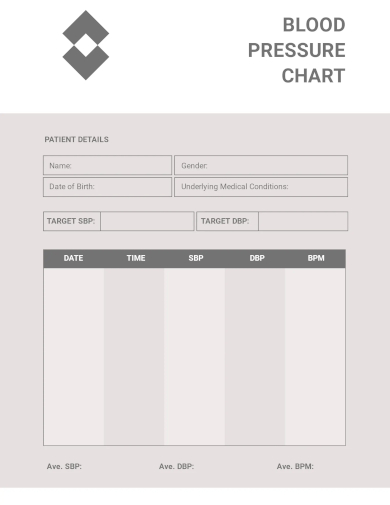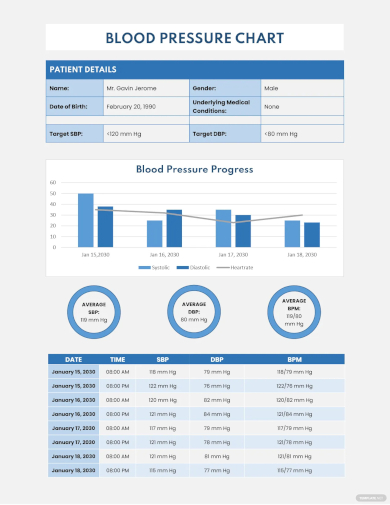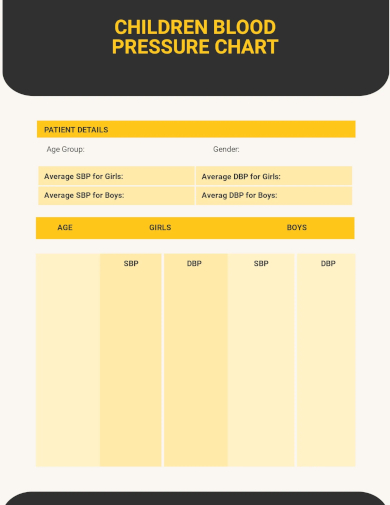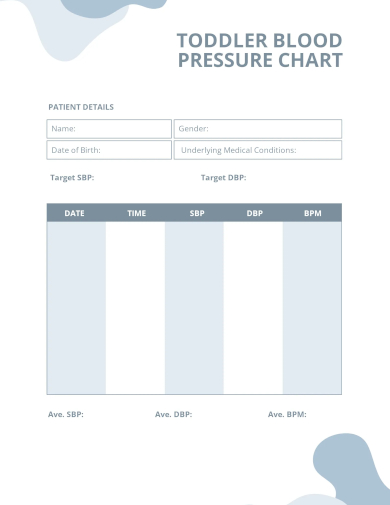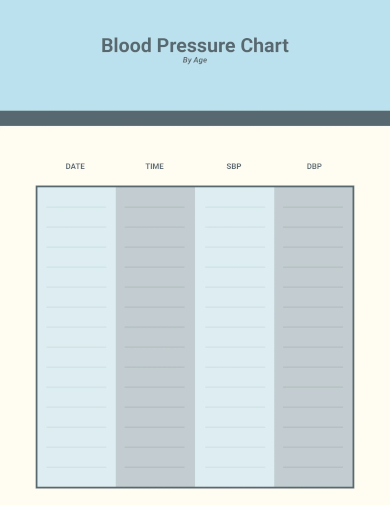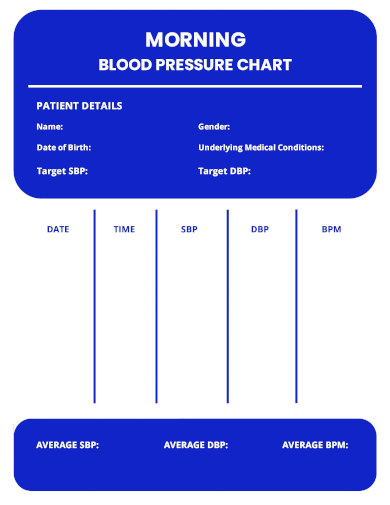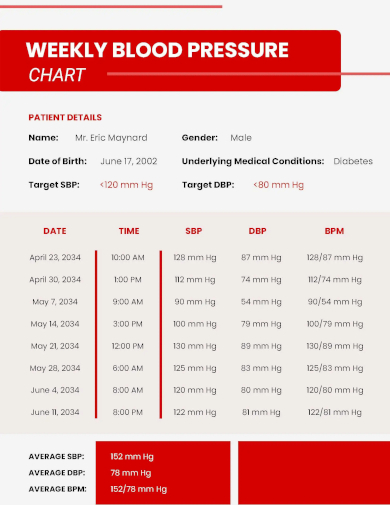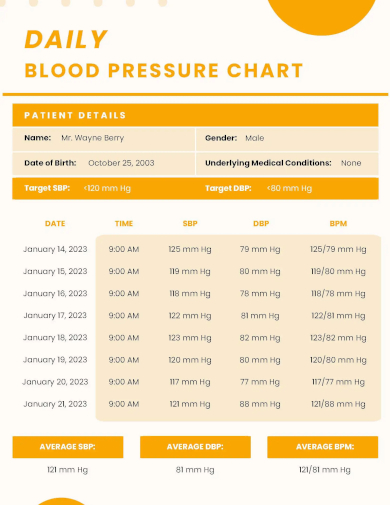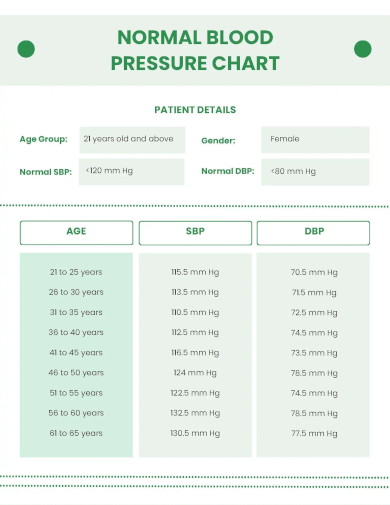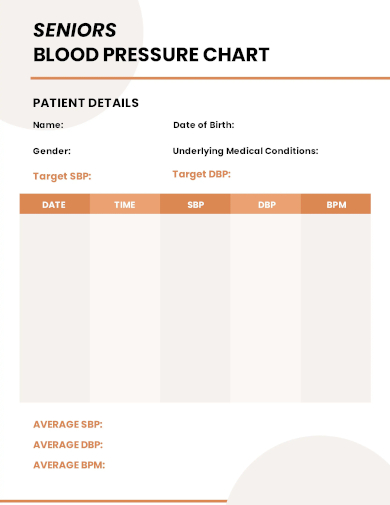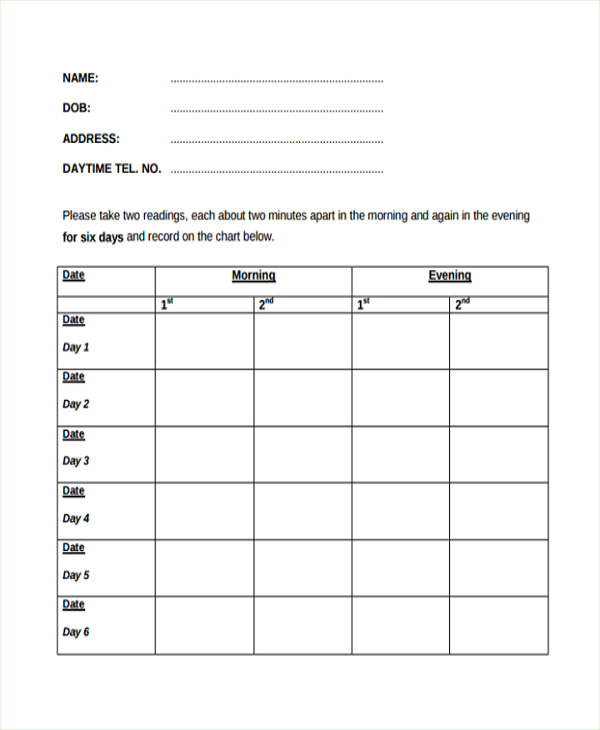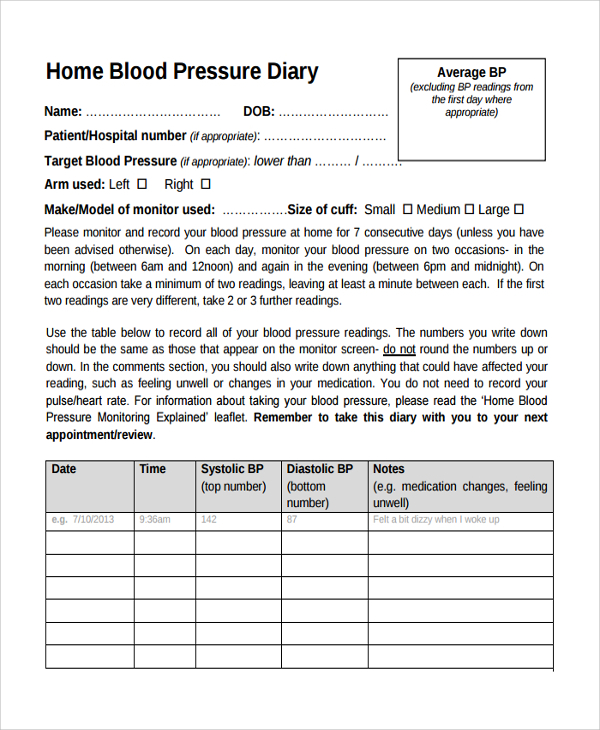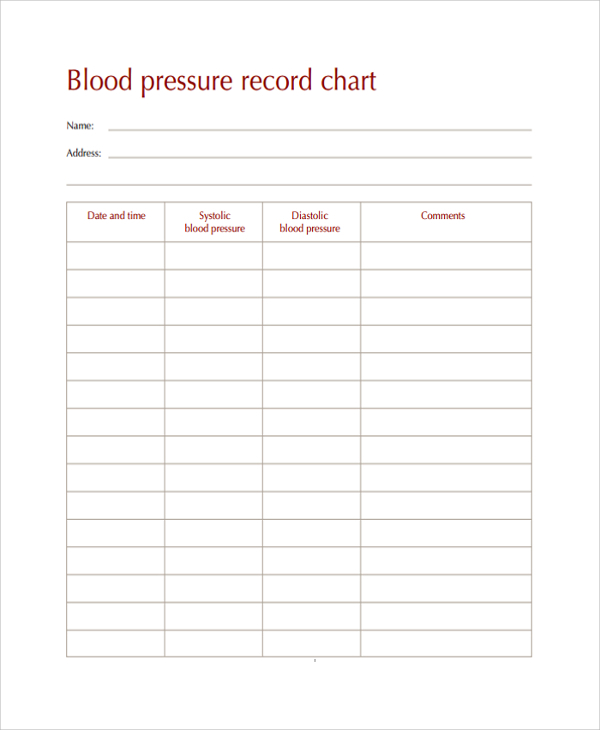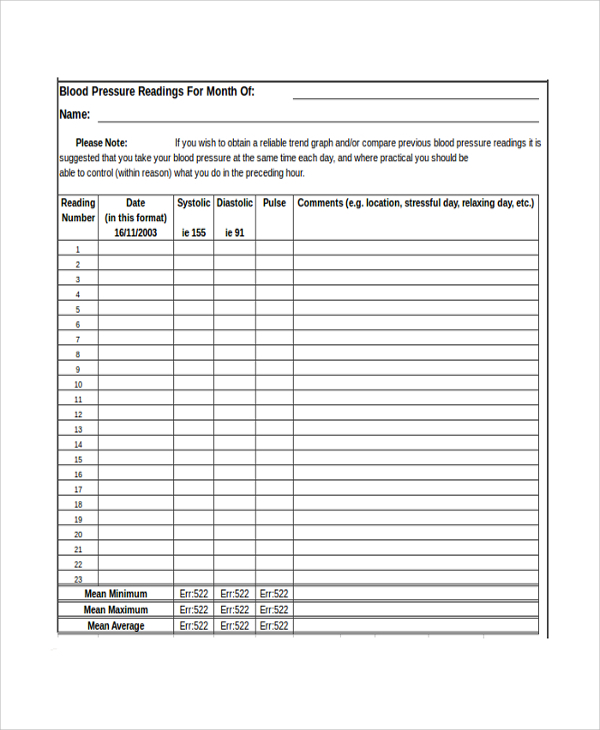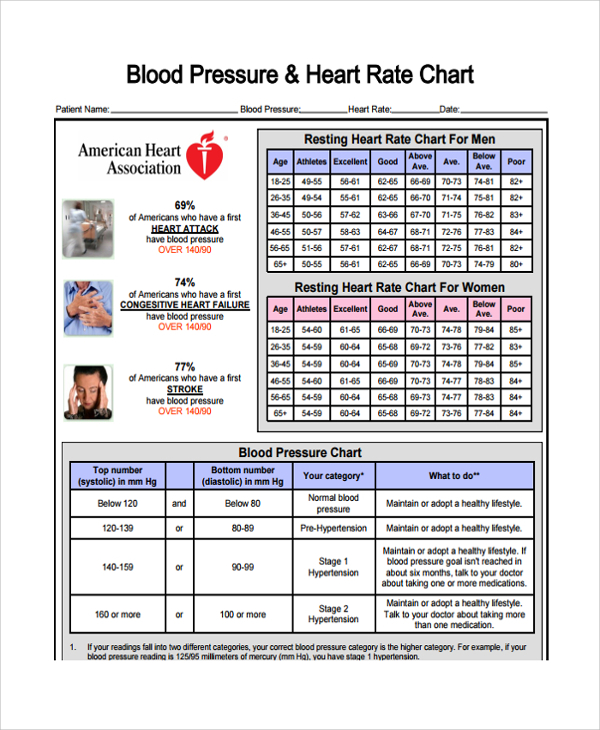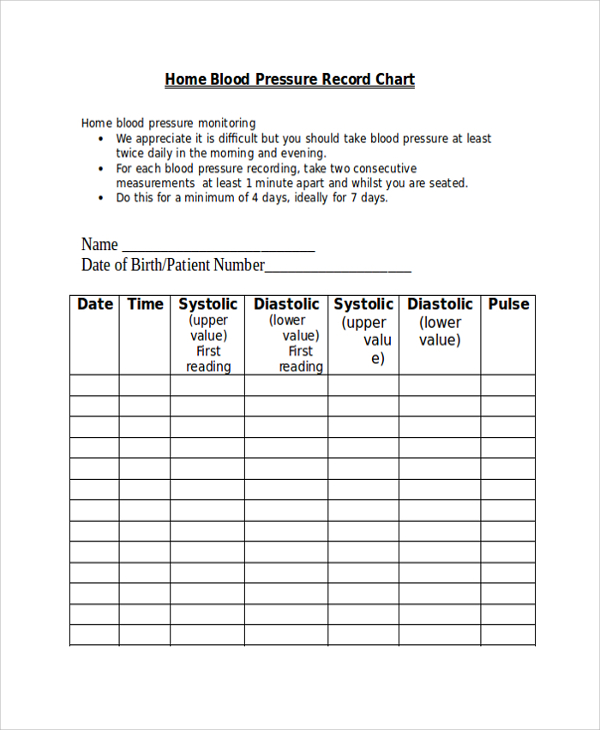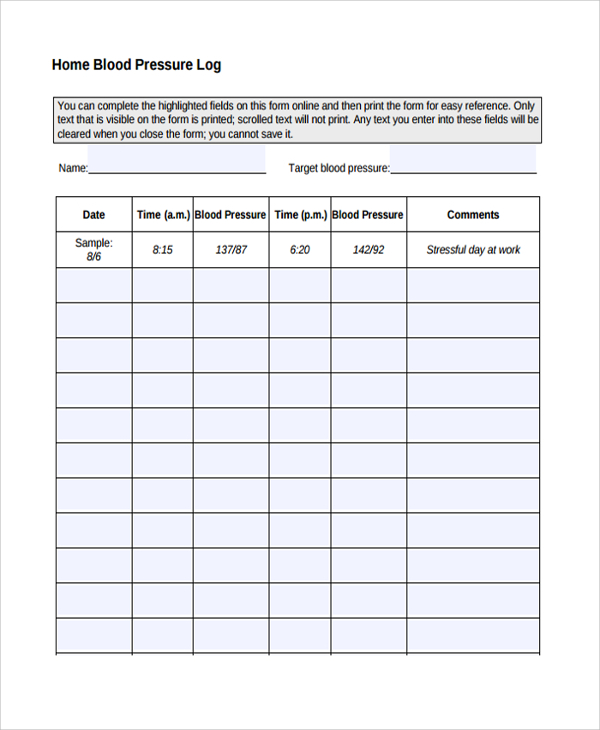The blood pressure is a common issue in today’s stressful life, and every disease big or small or heart problems etc is accompanied by some low or high blood pressure in many people. That is why keeping a daily track is very important. Some pressure tracking is done to just keep a daily record for your own satisfaction, while others are to show to the doctor when you go for the visit. Some tracking helps you detect any changes in the BP after a medication or lifestyle is changed. You may also see Heart Rate Chart.
Blood Pressure Chart For Women Template
Blood Pressure Chart Over 65 Template
Blood Pressure Chart By Age And Weight And Gender Template
Free Blood Pressure Chart Template
Blood Pressure Chart By Age And Height Template
Gestational Blood Pressure Chart Template
Importance of Blood Pressure Chart
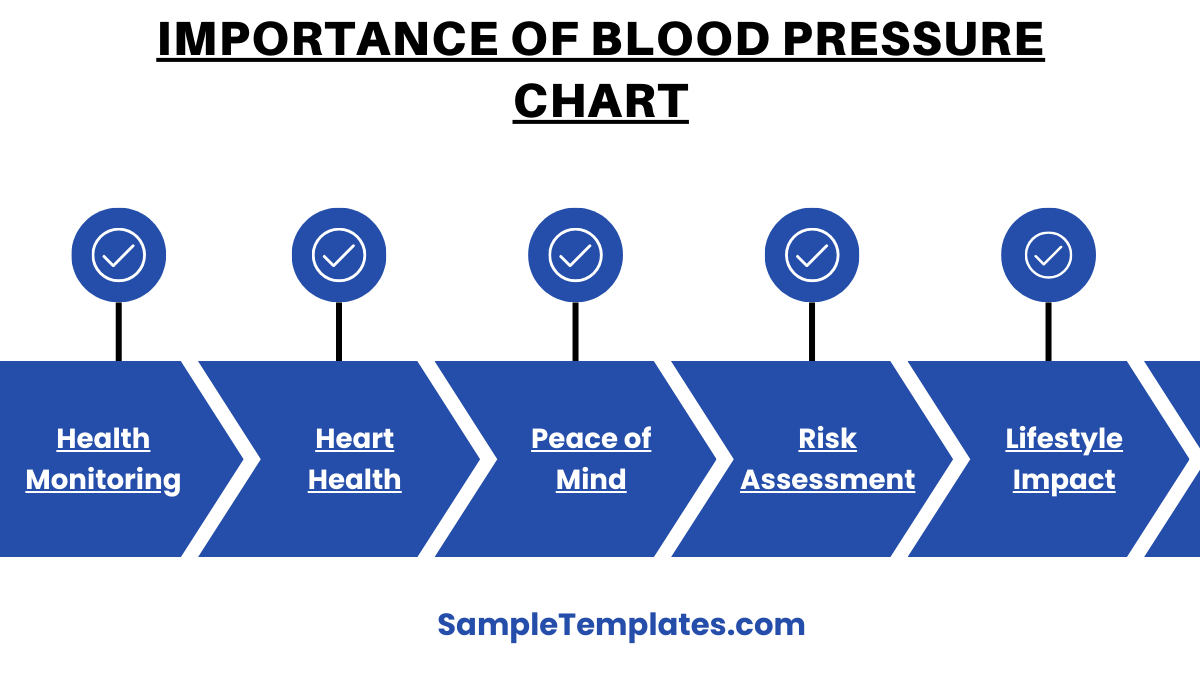
Blood pressure monitoring templates have immense importance for the parents or for their family member to help them out. This gives a ready format which is medically accepted at all clinics and centers and by all doctors. Hence one may use it freely. Another good reason to keep a BP tracker ready and handy is to keep a daily track. You may also see Hospital Organizational Chart .
- Health Monitoring: Regularly tracking blood pressure helps monitor overall health and detect any abnormal changes early.
- Hypertension Management: Identifies high blood pressure, enabling timely intervention to prevent complications.
- Heart Health: Helps in maintaining heart health by keeping track of blood pressure, reducing the risk of heart disease.
- Medication Effectiveness: Assesses how well blood pressure medications are working and if adjustments are needed.
- Lifestyle Impact: Evaluates the effectiveness of lifestyle changes, such as diet and exercise, on blood pressure.
- Risk Assessment: Identifies individuals at risk of developing conditions like stroke or kidney disease due to high blood pressure.
- Doctor’s Insight: Provides healthcare professionals with valuable data to make informed decisions about treatment plans.
- Peace of Mind: Regular monitoring provides reassurance and peace of mind by keeping track of one’s health status.
Free Blood Pressure Chart For Older Women Template
Blood Pressure Chart By Age Template
Infant Blood Pressure Chart Template
Free Blank Blood Pressure Chart Template
Blood Pressure Chart By Age And Gender Template
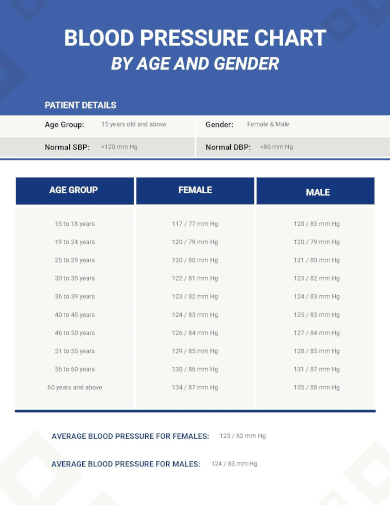
Blood Pressure Chart Template
How to Use Blood Pressure Chart
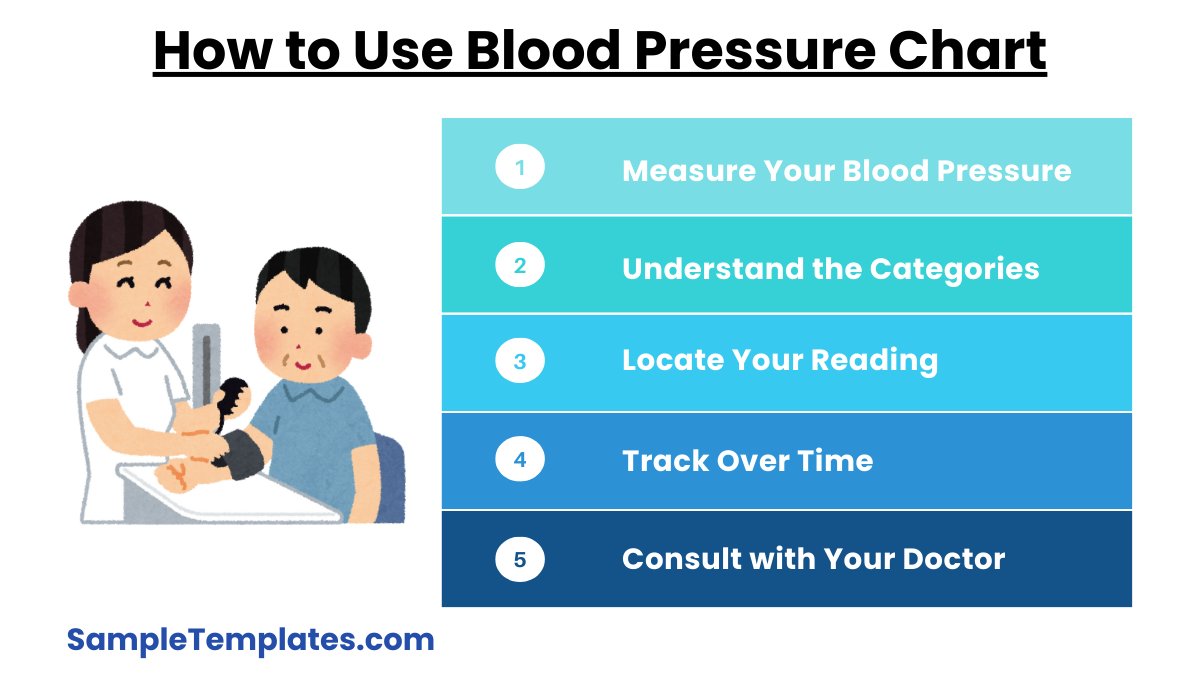
Using the BP monitoring templates is easier than you may imagine. You only need to download one to your computer. Then you can print the blank template and fill it up daily with a pen or pencil. Else you may keep the same on a computer, and digitally record the readings every day, and get a print only when you are going to visit your doctor. You may also see Blank Organizational Chart .
Using a blood pressure chart can help you monitor and understand your blood pressure readings. Here’s a step-by-step guide on how to use it effectively:
Step-by-Step Guide
- Measure Your Blood Pressure:
- Use a reliable blood pressure monitor.
- Follow the instructions for proper use, including sitting quietly for a few minutes before taking the measurement.
- Record the systolic (top number) and diastolic (bottom number) pressures.
- Understand the Categories:
- Normal: Systolic < 120 mm Hg and Diastolic < 80 mm Hg.
- Elevated: Systolic 120-129 mm Hg and Diastolic < 80 mm Hg.
- Hypertension Stage 1: Systolic 130-139 mm Hg or Diastolic 80-89 mm Hg.
- Hypertension Stage 2: Systolic ? 140 mm Hg or Diastolic ? 90 mm Hg.
- Hypertensive Crisis: Systolic > 180 mm Hg and/or Diastolic > 120 mm Hg. This requires immediate medical attention.
- Locate Your Reading:
- Find where your systolic and diastolic numbers intersect on the chart.
- Determine which category your reading falls into.
- Track Over Time:
- Regularly record your readings to see trends.
- Use a notebook, app, or a dedicated blood pressure log.
- Consult with Your Doctor:
- Share your readings with your healthcare provider.
- Discuss any concerns or unusual patterns.
Tips for Accurate Readings
- Consistency: Measure at the same time each day.
- Position: Sit with your back straight and supported, feet flat on the floor, and arm supported at heart level.
- Avoid: Caffeine, exercise, and smoking for at least 30 minutes before measuring.
- Multiple Readings: Take two or three readings a minute apart and use the average.
Sample Blood Pressure Chart
| Category | Systolic (mm Hg) | Diastolic (mm Hg) |
|---|---|---|
| Normal | Less than 120 | Less than 80 |
| Elevated | 120-129 | Less than 80 |
| Hypertension Stage 1 | 130-139 | 80-89 |
| Hypertension Stage 2 | 140 or higher | 90 or higher |
| Hypertensive Crisis | Higher than 180 | Higher than 120 |
Monitoring Tools
- Manual Logs: A notebook or paper chart.
- Digital Apps: Mobile apps designed for tracking blood pressure.
- Wearable Devices: Some smartwatches and fitness trackers.
By using a blood pressure chart, you can actively participate in managing your health and detecting potential issues early.
Children Blood Pressure Chart Template
Toddler Blood Pressure Chart Template
Blood Pressure Chart Age Wise Template
Morning Blood Pressure Chart Template
Weekly Blood Pressure Chart Template
Daily Blood Pressure Chart Template
Normal Blood Pressure Chart Template
Seniors Blood Pressure Chart Template
Benefits of Blood Pressure Chart
Using a blood pressure chart sample offers numerous benefits, helping you maintain better health and manage potential issues effectively. Here are some of the key benefits:
Benefits of Using a Blood Pressure Chart
- Early Detection of Hypertension:
- Regular monitoring allows you to detect high blood pressure early, even before symptoms develop. Early detection can prevent complications such as heart disease, stroke, and kidney damage.
- Track Trends and Patterns:
- A blood pressure chart helps you identify trends and patterns over time. You can see how your blood pressure changes in response to lifestyle factors, medications, and other variables.
- Informed Discussions with Healthcare Providers:
- Detailed records of your blood pressure readings provide valuable information for your healthcare provider. This data can guide treatment decisions and adjustments.
- Motivation for Lifestyle Changes:
- Seeing improvements in your blood pressure readings can motivate you to maintain healthy lifestyle habits, such as diet, exercise, and stress management.
- Medication Management:
- If you are on blood pressure medication, tracking your readings helps determine the effectiveness of your treatment and whether adjustments are needed.
- Prevention of Hypertensive Crisis:
- Regular monitoring can alert you to dangerously high readings, allowing for timely intervention and preventing hypertensive crises.
- Personal Health Awareness:
- Being aware of your blood pressure status empowers you to take charge of your health and make informed decisions.
- Reduced Anxiety:
- Consistent monitoring can reduce anxiety by providing a clear picture of your health status and helping you avoid unnecessary concerns about occasional high readings.
- Improved Outcomes:
- Studies show that people who monitor their blood pressure regularly and share the results with their healthcare providers achieve better blood pressure control and overall health outcomes.
Blood Pressure Chart Template
This i blood pressure template for recording daily schedule BP at day and night. It is a plain and simple format for your own record so that you can know the daily record and check or compare it at a later date if required.
Sample Blood Pressure Monitoring Chart Template
This format contains various fields like, the time of recording and the date, and you also get an option to attach sample notes if required. This is very important to keep track of changes in BP with a major change in lifestyle or medication. Also, it helps track any physical problems which you may keep a note of to later recall and tell your doctor.
Blood Pressure Record Chart Template
Often you look for a simple chat format where you just fill in your daily systole and ductile BP, and a one line comment if required. This exact format is what you get here, and it also helps in daily data tracking of BP, or may be used to keep a track whenever you check the BP at any date.
Blood Pressure Chart Template Excel
This sample form of the template is to monitor and write the BP on Excel. Excel is a nice application to keep chart and report in organized form, and if you have sample plans of preparing graphs or charts from the data, then excel is the best format. In this template, you will get the fields ready to input values daily.
Blood Pressure Log Chart Template
Sample Blood Pressure & Heart Rate Chart Template
Female Blood Pressure Chart Template
Home Blood Pressure Record Chart Template
Sample Blood Pressure Log Chart Template
Blood Pressure Readings Chart Template
Why Blood Pressure Tracking is so Important?
Tracking of BP is one of the most important things to do daily if you actually have an elevated or reduced BP. BP is one of the sole causes of other body problems and often the other way round, many body problems trigger a high or low BP issue. In any problem, the BP must be tracked daily, and the analyzed on a monthly or weekly view to analyze certain patterns. The doctors appreciate these kinds of payment records a lot, as it helps monitor and understand the body of a patient better.
What is a good blood pressure by age?
A good blood pressure generally is below 120/80 mm Hg for adults of all ages. However, slightly higher values may be acceptable for older adults (60+), typically below 140/90 mm Hg. Always consult with a healthcare provider for age-specific guidelines.
What range of blood pressure is OK?
Normal blood pressure is below 120/80 mm Hg. Elevated blood pressure is 120-129/less than 80 mm Hg. Hypertension Stage 1 is 130-139/80-89 mm Hg, and Stage 2 is 140 or higher/90 or higher mm Hg. Hypertensive crisis is above 180/120 mm Hg and requires immediate medical attention.
Which blood pressure number is more important?
Both systolic (top number) and diastolic (bottom number) are important, but systolic pressure is a key predictor of cardiovascular risk, especially in older adults. Elevated systolic pressure often indicates greater risk of heart disease and stroke.
What time is blood pressure usually the highest?
Blood pressure is usually highest in the morning, typically between 6 a.m. and noon, due to the body’s natural circadian rhythm. It gradually decreases throughout the day and is lowest during sleep.
When not to take blood pressure?
Avoid measuring blood pressure immediately after waking, right after eating, after exercise, when stressed or anxious, or if you need to use the bathroom. These conditions can give inaccurate readings. Wait at least 30 minutes after any of these activities.
Blood pressure monitoring gives answers to many problems which you may realize at a later date. A day to day tracking of pressure in serious or aged patients give the doctor a direction to treat, and let’s understand the case study well. You will get home BP monitor to take care and track the BP daily, and then may use any of these formats to keep a record on paper or computer.
Related Posts
Sample Business Card Templates
Sample Cashier Job Descriptions
Questionnaire Samples
FREE 10+ Sample HR Resource Templates in PDF
FREE 10+ HR Consulting Business Plan Samples in MS Word | Google Docs | Pages | PDF
FREE 49+ Sample Job Descriptions in PDF | MS Word
FREE 16+ Nonprofit Budget Samples in PDF | MS Word | Excel | Google Docs | Google Sheets | Numbers | Pages
FREE 13+ Academic Calendar Templates in Google Docs | MS Word | Pages | PDF
FREE 10+ How to Create an Executive Summary Samples in Google Docs | MS Word | Pages | PDF
FREE 23+ Sample Event Calendar Templates in PDF | MS Word | Google Docs | Apple Pages
Company Profile Samples
FREE 10+ Leadership Report Samples [ Development, Training, Camp ]
FREE 24+ Sample Payment Schedules in PDF | MS Word
FREE 10+ Return to Work Action Plan Samples in PDF | DOC
Autobiography Samples & Templates
